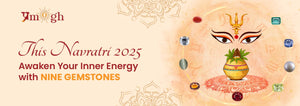Every year, as Navratri arrives, there is a special kind of energy and piousness in the atmosphere. Houses are filled with the aroma of incense, the chanting of bhajans, and the silent power of prayer is felt everywhere. But most importantly, Navratri is a journey, a nine-day spiritual walk through the various divine forms of Maa Durga.
|
Sharad Navratri will take place this year from September 22, 2025, to October 1, 2025. |
Each day of Navratri allows us to meet a different form, a different manifestation of Goddess Durga. Each avatar embodies a different aspect of strength, wisdom, love, fierceness, peace, or detachment, and collectively, they allow us to discover many of the layers in ourselves.
It's even more wonderful to see how these divine characteristics coincide with the rare energies of the Navratnas (9 sacred gems in Vedic astrology). Buying and wearing these stones during Navratri will provide infinite opportunities to invoke and align our own inner world with these cosmic energies.
Let's take this journey together, one day, one aspect of the goddess, and one gemstone at a time.
How Each Day of Navratri 2025 Aligns with a Planet and a Gemstone
Navratri is bigger than a festival. It's an opportunity to clear your path, realign with your purpose, and go forward with the power of Maa Durga, and the gentle support of the Navratnas alongside you.
Every Navratna is related to a planet and carries energy that can assist and support us, particularly during Navratri, when spiritual energy is very high. Wearing the correct gemstone on the correct day helps to break the blocks, which planets can create, and gets us in sync with the attributes each goddess embodies.
Let’s now take a look at the nine avatars of Maa Durga, and how each one beautifully connects with a specific Navratna.
Day 1: Maa Shailputri: The Strength of Ruby Stone
The very first day of Navratri signifies the initiation of a very spiritual experience. It begins with worshiping Maa Shailputri, the daughter of the Himalayas. Her name itself means strength and stability. Maa Shailputri rides a bull and is holding a trident in one hand and a lotus in another; and this avatar represents the power that arises from being rooted deeply.

In Vedic astrology, this grounding and willpower energy is most closely associated with the Sun, and the gemstone that embodies the power of the Sun is the Ruby.
Ruby, or Manik stone, is referred to as the king of gemstones. It symbolizes inner strength, confidence, and clarity. Similar to how Maa Shailputri creates a foundation for the remaining Navratri days, Ruby stone creates the foundation of one's own belief and personal power. It's particularly useful for those who are lacking in confidence or are unsure of themselves, as it brings focus, direction, and inner courage.
Day 2: Maa Brahmacharini: The Peace of Pearl
The second day of Navratri is for Maa Brahmacharini, the goddess of devotion, discipline, and inner force that arises from peaceful persistence. She walks barefoot, carrying a japa mala and a kamandalu, representing a life of tapasya and spiritual aspiration. Her way is not rapid or boisterous, but constant and firm.

This calm, serene power is wonderfully linked to the power of the Moon, and the gemstone of the Moon is the Pearl, or Moti.
According to Vedic astrology, the Moon is a planet that rules our emotions, our minds and our inner peace. Just like Maa Brahmacharini, the energy of the Moon is soft, gentle, and deeply emotional. When you wear Pearl, it balances emotions, reduces anxiety, and provides the clarity of mind. Pearl is best suited for people who frequently feel overwhelmed or affected by the people and situations around them.
Day 3: Maa Chandraghanta: The Courage of Red Coral
On the third day of Navratri, we worship Maa Chandraghanta, represented as the warrior avatar of Maa Durga. Her name derives from a crescent moon shaped like a bell (ghanta) located at the centre of her forehead. She represents fierceness, protects all and is always prepared to stand against injustice and cruelty. Deep below all that fierceness is an infinite well of compassion and a heart that wishes nothing more than to protect her devotees.

This dynamic combination of care and courage comes very close to the action nature of Mars and the stone associated with Mars is Red Coral, or Moonga.
Red Coral is infamous for its strength-imparting properites. It energizes, encourages, and empowers the wearer to tackle difficulties head-on. In Vedic astrology, Mars symbolizes energy, motivation, and determination, traits that characterize Maa Chandraghanta. However, Mars also carries a protective quality, as does the goddess herself, who wields arms not out of rage but out of love and responsibility.
Day 4: Maa Kushmanda: The Wisdom of Yellow Sapphire
The fourth day of Navratri is for honouring Maa Kushmanda, the goddess who is said to have created the whole universe with a gentle smile. Her name originated from three words: Ku (little), Ushma (heat or energy), and Anda (cosmic egg). This indicates that even the faintest spark of her divine power can create whole worlds into existence.

This creative, luminuous energy is directly associated with Jupiter, the planet of wisdom, growth, and abundance. And the Yellow Sapphire, or Pukhraj, is the gemstone saturated with the energy of Jupiter.
Pukhraj stone is usually worn for prosperity; not just monetary, but also spiritual and emotional. It helps to open the door to progress, assists to make positive decisions, and brings opportunities that align to our higher calling. Just as Maa Kushmanda is the embodiment of the beginning of life, a Yellow Sapphire helps you begin something new with optimism, clarity, and confidence.
Day 5: Maa Skandamata: The Wisdom of Emerald Stone
The fifth day of Navratri is dedicated to Maa Skandamata, the motherly incarnation of Durga. Seen holding her son, Lord Kartikeya (also known as Skanda), in her lap, she is a representation of unconditional, pure love and protection. Along with her gentleness comes great wisdom and spiritual strength. Her blessings have the power to bring peace, mental clarity, and deep emotional healing.

This balance of heart and mind connects well with the energy of Mercury, the planet that rules communication, intellect, and reasoning. And the corresponding gemstone for Mercury is the Emerald, or Panna stone.
Emerald has been a stone of intelligence, peace, and emotional equilibrium for ages. It enhances concentration, clears anxiety, and improves the skill of communicating effectively. But it is not only the way that we express ourselves; it is also the way we perceive things. Emerald stone brings our thoughts and feelings into harmony which is precisely what Maa Skandamata represents.
Day 6: Maa Katyayani: The Brilliance of White Sapphire
On the sixth day of Navratri, we all worship Maa Katyayani, which is one of the most powerful manifestations of Durga. She is considered the warrior goddess, who was born to eliminate negativity and bring about equilibrium. She is powerful in a straight-forward, bold, and purposeful manner. She is seen holding weapons in her hand, riding a lion, and is considered to bestow courage, clarity, and success in overcoming big challenges, particularly those connected with injustice or fear.

Her vigor indicates White Sapphire (Safed Pukhraj), which is a Venus-ruled gemstone.
White Sapphire attracts luxury, beauty, and maturity of emotions. It encourages loving relationships and enhances one's self-esteem without fulfilling ego. As Maa Katyayani, so does this stone balance power with poise.
Day 7: Maa Kaalratri: The Clarity of Cat’s Eye Stone
On the seventh day of Navratri, we worship Maa Kaalratri, the goddess who embodies the power to annihilate evil, fear, and ignorance. She is black, uncontrolled, and fierce, with her hair as wild as it can be, an unafraid look in her eye, and a stance that tells you she fears no one. And yet in this frightening form, her energy is intensely protective and cleansing. She cleanses darkness not only from the world, but from our own selves.

In Vedic astrology, this energy of facing uncertainty, embracing change, and breaking through illusions is closely associated with the shadow planet Ketu. Lehsunia stone, also known as Cat's Eye, is the gemstone of Ketu.
Cat's Eye is a strong and frequently underappreciated stone. It is said to bring instant clarity, intuitive power, and shield from unseen enemies or evil influences. Like Maa Kaalratri, it doesn’t work through softness; it works through truth. It's particularly useful for individuals experiencing significant life transformation, spiritual disorientation, or circumstances where things do not make logical sense. Cat's Eye stone allows you to perceive what your physical eyes cannot.
Day 8: Maa Mahagauri: Purification of Hessonite
We worship Maa Mahagauri, meaning "the one with a fair complexion," on the eighth day of Navratri. She embodies purity, serenity, and the energies of transformation through spiritual purification. Following the intense wars experienced by the goddess in her previous avataras, Maa Mahagauri is depicted as serene and radiant, signifying a new beginning and spiritual rebirth.

Her energies resonate with Hessonite (Gomed stone), the Rahu-ruled gemstone.
Hessonite stone cleans the energy of greed, ego, confusion, and material attachment. It helps to remove illusions and brings you back to what is important. If you have been chasing the wrong objectives or you are spiritually stuck, this is your opportunity to change it.
Mahagauri gives you a fresh start. Gomed stone prepares you for it.
Day 9: Maa Siddhidatri: The Completion of Blue Sapphire
Navratri concludes with Maa Siddhidatri, the provider of siddhis (supernatural powers) and the perfect completion of the divine journey. She is symbolized as balance, perfection, and the ultimate unification of the soul with divine power.

The stone of this day is Blue Sapphire (Neelam stone), governed by Saturn.
Blue Sapphire is among the strongest stones used in Vedic astrology. It's said to induce sharp concentration, discipline, and profound change, but only when one is willing to become responsible for his or her own journey. Similar to Maa Katyayani, Neelam stone does not reward lukewarm efforts. It is most effective for individuals who are committed to development and prepared to confront both truth and adversity.
Final Thoughts
During the nine days of Navratri we will see every aspect of Maa Durga demonstrating something important- maintaining strength, holding patience, speaking our truth, or letting go of what no longer serves us. These nine days are not simply about rituals, they are about reconnecting with ourselves.
However, sometimes, no matter how we try to walk the right path, things just fail to change. We encounter delays, feel discouraged or stuck emotionally. In Vedic astrology, this usually happens when planetary energies get out of balance. That is where gemstones enter the picture.
This Navratri, as you celebrate the goddess Durga in her numerous avatars, consider how the energy of these 9 gemstones can be of help to you in your journey. Whether you choose to wear one or simply hold their significance in your heart, the grace of Maa Durga and the celestial energy of Navratnas can illuminate your path each day.
FAQs
When will Sharad Navratri 2025 start?
This year, Sharad Navratri, which is also called Shardiya Navratri, is going to start on 22 September 2025, and will end on 1 October, 2025.
When will Navratri 2025 end?
On October 1, 2025, Navratri will come to an end, and the following day will be dedicated to the celebration of Dussehra.
When is Dussehra in 2025?
Vijayadashami, another name for Dussehra, will be celebrated on October 2, 2025. It signifies the conclusion of the Navratri festival and the triumph of good over evil.
When is Maha Navami 2025?
October 1, 2025, will be Maha Navami, the ninth and last day of Navratri before Dussehra.


















































